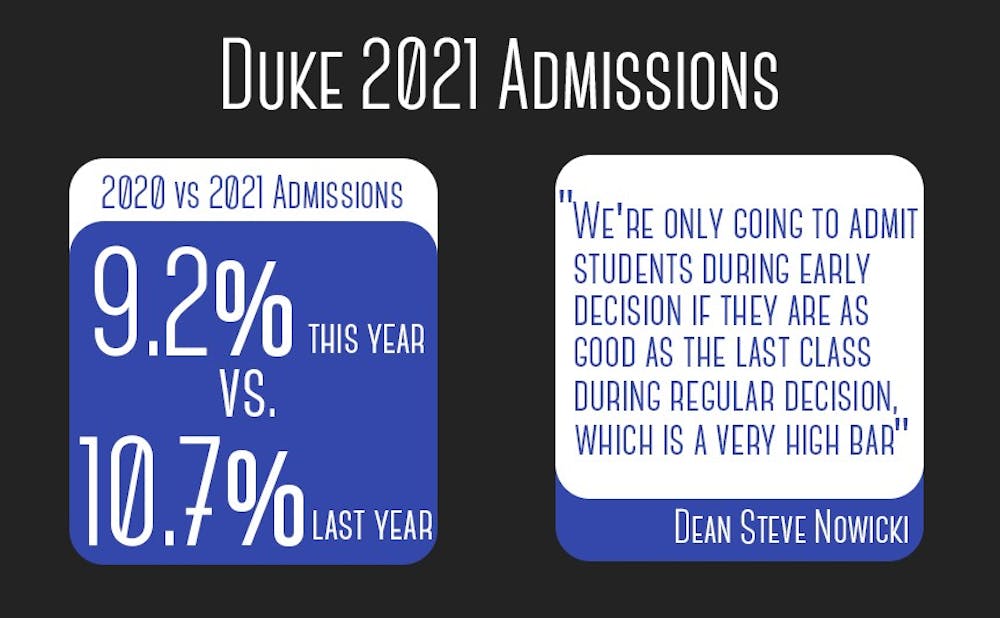Duke boasted a record-low regular decision acceptance rate this year, but how does the University compare to its peer institutions?
The University accepted 7.3 percent of regular decision applicants and 9.2 percent of prospective students overall, including early decision applicants. These numbers constitute lower rates than last year's 8.7 percent for regular decision applicants and 10.7 percent overall.
The overall 2017 acceptance rate is comparable to that of University of Pennsylvania—which was also 9.2 percent. But Duke's rate was lower—a typical indicator of selectivity—than Dartmouth University’s 10.4 percent overall admittance rate and Johns Hopkins University’s 11.8 percent rate.
“I'm going to have to be honest and say I think we're just staying competitive,” said Stephen Nowicki, dean and vice provost for undergraduate education. “I think we're at the highest level. Duke is in the sphere where the jockeying of rankings just doesn't matter because the differences are so fine.”
Christoph Guttentag, dean of undergraduate admissions, could not be reached for comment.
Based solely on overall acceptance rate numbers, some peer institutions would seem to be more selective than Duke was this year. Stanford University admitted 4.7 percent of applicants, Harvard University admitted 5.2 percent and Northwestern University admitted nine percent of applicants.
The overall yield—or the percentage of accepted applicants choosing to attend Duke rather than another institution—has been increasing the last several years. Five years ago, the University's yield was 42 percent. That number rose to nearly 50 percent for the current sophomores in the Class of 2019 and 50 percent for the current first-year Class of 2020. These yield numbers include both regular and early decision applicants.
“We've had to adjust our admissions because we now realize that more of the people that we are offering admissions to are choosing to come to Duke,” Nowicki said. “We're now 50-50 with almost all of our chief co-admits.”
Still, the University's yield rate lags behind a number of peer institutions. In 2016, the yield was 80 percent at Harvard, at least 64 percent at Penn and 53 percent at Dartmouth.
“Yield is a factor that goes into rankings, and it's a thing that high school counselors think about,” Nowicki said. “That's not irrelevant, but I think Duke is at a point now where I think we don't really need to care too much about that because we're already getting some of the best students in the world.”
Nowicki attributed the rising yield rate to the strength and reputation of Duke alumni. He recounted a public opinion survey of people with no ties to the "Ivy Plus" schools, which include the Ivy League schools, Stanford, the University of Chicago, the Massachusetts Institute of Technology and Duke. When participants were asked whether they liked graduates of each university, Nowicki said Duke, and not Harvard, was at the top of the list.
“How do you know that somebody is a graduate of Harvard? Because they tell you. Because they're using that as a sort of ‘I’m from Harvard, I must be better than you,’” he said. “How do you know somebody is a graduate of Duke? Because when March comes, we all wear our t-shirts. And it's disarming.”
Nowicki added that alumni drive a school’s reputation. Duke has an advantage over some peer institutions, he said, because its graduates are not “full of themselves.”
The construction of a new dorm on East Campus is not likely to increase the acceptance rate at Duke, he added.
“The new residence hall that's being built is definitely not about increasing class size because it is completely about, in the long run, closing down [East Residence Hall], Jarvis and Epworth, because they're just not suitable for residents living,” he said.
Nowicki also explained that the administration has discussed expanding the class size, but the discussion has been tabled until the incoming President Vincent Price succeeds President Richard Brodhead in July.
The early decision process at Duke has changed in recent years to make early decision applicants a greater portion of each class, Nowicki said. For example, early decision applicants this year are expected to make up 50 percent of the Class of 2021. He noted that this trend differs at various universities, but added that the University was not trying to manufacture lower acceptance rates for regular decision applicants.
“There are some schools who play that game because it’s good for the rankings,” Nowicki said. “We made the decision explicitly that that's not the game we're going to play—we're only going to admit students during early decision if they are as good as the last class during regular decision, which is a very high bar.”
Get The Chronicle straight to your inbox
Signup for our weekly newsletter. Cancel at any time.

